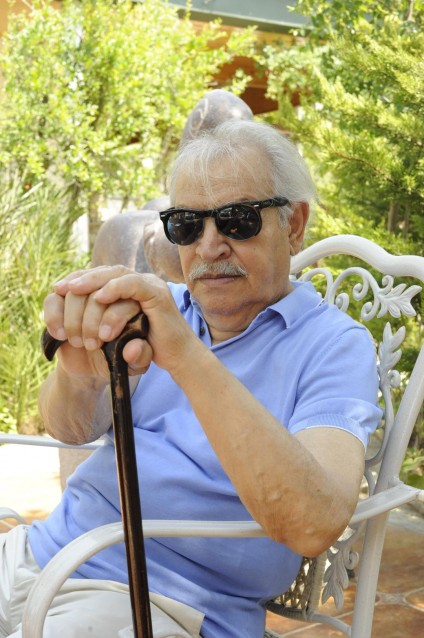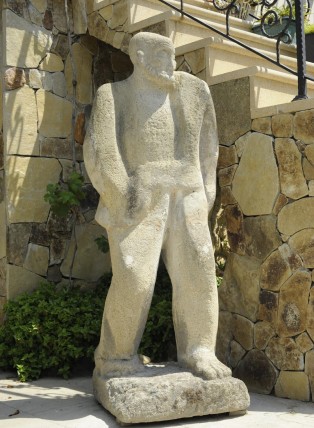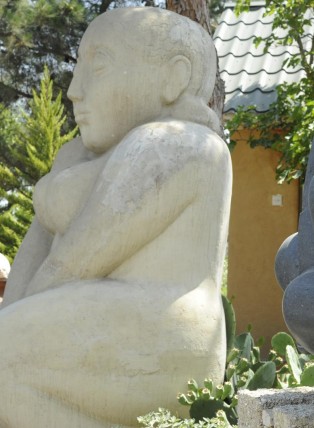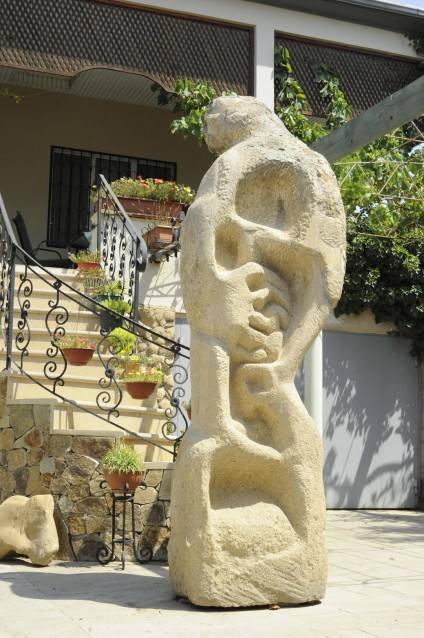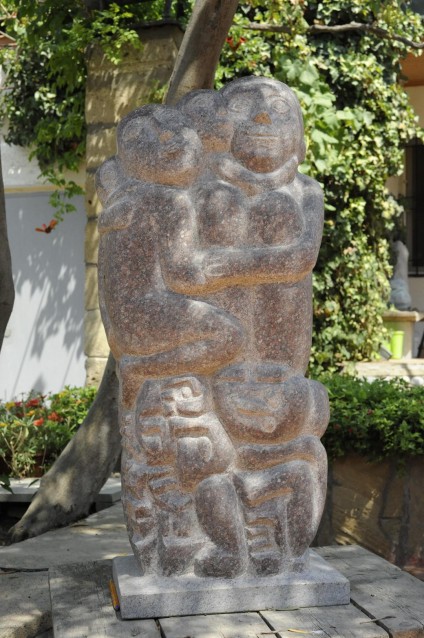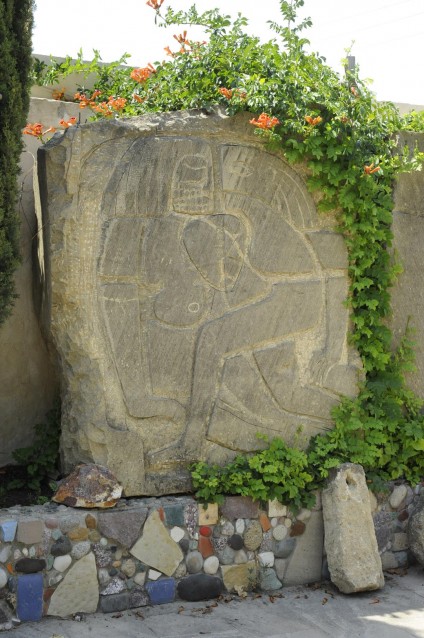When the lights are switched off, paintings disappear, but you can still stumble upon a sculpture. This thought doesn’t belong to me, but I’ll say the rest in my own words.
Fazil Najafov is like Marquez’s novels. He represents a combination of wisdom and mischief, sensuality and spiritual grace, knowledge and ease. And these sit together so organically that all that remains is to silently contemplate the multifarious creativity of this Azerbaijani sculptor.
VoA - How did your passion for sculpture begin?
FN - I started to take an interest in it when I was seven years old. My father’s friends played a certain role. My father was a furrier, a fur master, and his friends often came to see him... My dad showed them my paintings, they were surprised and praised me, and I was eavesdropping. Yes, I was vain. Without that there probably wouldn’t have been any development. But I had to relate to this with understanding and this depended on an inner sense of what was right.
After finishing secondary school, I went to art school. We had a wonderful teacher who had just come from Moscow. He was giving us everything he knew, and the painting class was a real holiday. We would pull a fresh sheet over the stretcher frame and look forward to something new! I enjoyed when something worked out well but when it didn’t I would come home in a terrible mood. I couldn’t wait for the next day to come and fix it.
Then there was the Surikov Institute. I was accepted without any difficulty and even fooled about at the entrance examinations. From 110 people, only eleven could pass. They were mainly Muscovites, MSAS graduates (Moscow Secondary Art School, established in 1939 - Ed.), children of the teachers, but I managed it without connections even so.
We had four tasks to complete. I finished them all easily and thought to myself: I’ve already passed! We were given two days to make the last drawing with a model. I didn’t like the model, turned over the examination sheet and moved on to another model. The guys were telling me: Fazil, what are you doing?! You shouldn’t do that! I said to myself: Everything is possible! I got a B for that – I broke the rules. For all the other tasks I got an A.
I remember Gleb Borisovich, an imposing-looking professor, appearing in the classroom... Put your pencils aside and listen to me. We will draw three heads on the same piece of paper. I thought: Three heads on one piece of paper! What’s this – a drawing club?! I was disappointed with the Moscow institute. There was a very strong school in Baku in those days. When classmates approached me and looked at my sketches, they consoled themselves by saying: Well, this is the Baku school after all.
What about recognition from teachers at the academy? Did you get it?
There was an exhibition in Moscow, and my drawing teacher, the artist Dmitry Zhilinsky, went to it. While studying at the academy, I never heard a word of praise or criticism from him. And suddenly I saw him approaching. Wow! Zhilinsky himself is coming towards me, I thought to myself in surprise. And he says: My wife and I have been talking a lot at home about your work “Mirvari.” You’ve filled this form so well!
The front part of the House of Actors is still deco-rated with your original composition from copper and this work has a dramatic history. In the 1970s, it was censored and part of it was removed from the façade – tell us more about that.
I received the commission for the design of the House of Actors sometime in the 1970s. Here’s the façade. Have a think about what you can do, the leadership told me. So I began to think what drama and acting are about... Let this be a reflection of life through the theatre stage; a house for the intelligentsia with disputes, conversations, interesting meetings... I should create an intellectual composition, not a literal one, I thought.
They accepted a sketch of a copper high relief. The copper lining was unique, no one had done anything of this nature in Baku yet – there weren’t any specially trained welders, but I found someone who wouldn’t mind experimenting, so we began to work together.
Lots of young people came to the opening ceremony of the high relief and took a great interest in the composition. My opponents were also there. They couldn’t forgive me for the unconventional choice. The work was eventually removed at their suggestion for being formalistic. Because of this, I fell into a state of depression for three years. It was very painful... Yusif Gadymov, the architect of this building, advised me to leave part of the work – the part that hadn’t been chastized. It’s still there. Years later I was offered to return it in full, but I was already burnt-out.
Did you ever have to free yourself from the influence of any particular master?
You know, cracks appeared everywhere after the 1960s. Some secret books started to reach us, dealers sold books with Negro sculpture, the albums of Picasso and Dali, and all this changed hands very quickly. I was very impressed by Henry Moore! By the singularity of everything – form, content... The composition I created for the façade of the House of Actors contains some motifs inspired by his works. I did everything in my own way, but those in the know will certainly understand that the sculptor was familiar with Moore’s works. I soon completely moved away from this influence. And Moore changed too – there was little spirituality left in his works. In general, Western culture is very fond of the exterior of plastic art.
|
Fazil Najafov’s monumental works were demonstrated at the Venice Biennale in May 2015. His sculptures were also displayed at the famous exhibition The Constellation of Absheron, which was held in the Tretyakov Gallery in 2016, and at Born by the Wind of Azerbaijan, an exhibition organized by the Erarta Museum of Contemporary Art in St. Petersburg last summer.
|
Moore’s bronze casts are wonderful. They don’t change in colour or texture... though bronze should grow old. It should live up to its reputation: ancient bronze which has seen a lot.
Well, ok, you’re an adult, you’ve seen a lot, but what have you said to the world? Yes, the form has been masterfully done, but this isn’t enough, I often thought to my-self. So I decided to do things from stone, sculptures with reinforcement, with philosophy.
You have often admitted in your interviews that you like African primitive art. What generated this interest?
African sculpture is a special cultural phenomenon. It’s more about rhythm, large pieces, decorativeness, but in which everything is organically brought together.
I once saw a painted sculpture in the hall of African art at the Metropolitan Museum. There seemed to be nothing special about it, but it was so magnetic! It was a flat board of a valuable type, with blobs of paint here and there... It wasn’t a very eloquent sculpture, but I couldn’t stop looking at it!
You are one of a handful of people who knew the artist Ashraf Murad. He is now a painter recognized not only in Azerbaijan, but outside the country too. But he is known to have had quite a difficult life...
Ashraf would get up early in the morning and walk to Shikhov. He would return home late at night. He wore shabby shoes and the same shirt every day. His trousers were always falling down... My workshop was on the first floor of the House of Artists at the time, Ashraf Murad lived in the middle entrance. Ashraf probably felt that I had a soft spot for him, so he approached me from time to time and said very quietly: Can you lend me five roubles. I’ll pay you back on Thursday. And on Thursday he would appear with the money. No! Do take it! he insisted. Rasim [Babayev] told me about Ashraf asking him: Rasim, will you give me a tube of white paint? I’ll give it back. And he did give it back.
I saw Ashraf’s early works, those he made in Leningrad... Nothing special, academic. But after the incident with the policemen who beat him up, he began to paint in a different way.
You also knew Javad Mirjavadov, a very striking, extraordinary artist...
He was incredibly original! There was nothing Soviet about him. Javad didn’t receive an academic education but wasn’t small-minded. His spirit was unshakable. You can bend a piece of metal but as soon as you let go of it, it goes back to how it was before... Javad Mirjavadov was like that. He wasn’t afraid of anything. There was also something of a game in that – he was shy inside... A touching combination.
When you go somewhere, for example to Sheki, you come across a big tree with wide branches – lonely, independent... This is what Javad was like. He didn’t mix with anyone. He always kept himself at a distance. He had a special kind of energy. Like with Qobustan... You approach him and feel his radiation. Rasim Babayev felt this way too. We went to see him to recharge and were part of his close circle because we were also full of new ideas. His works didn’t sell, people didn’t understand him, but now! Finally, everyone’s understood the significance of his works.
|
The Absheron School – Fazil Najafov was part of a movement of avant-garde artists in the 1960s-1980s that sought to move beyond the limitations of Socialist Realism, the accepted artistic genre of the period. Living in Baku, this group of non-conformist artists, which also included Javad Mirjavadov, Tofiq Javadov, Rasim Babayev and Ashraf Murad, was drawn to the unusual landscapes and traditional culture of the Absheron peninsula and therefore became known as the Absheron School. It’s only in the post-Soviet era that their work has come to be fully appreciated. (For more on the Absheron School, see Moscow Finds Warmth in the Colours of the Absheron in the Winter 2016-17 issue of
Visions).
|
I remember Javad Mirjavadov once leaving his workshop and asking: Do you have some money? I answered, No. And then I remembered: Cavad, məndə çoxlu butılka var (I’ve got lots of empty bottles to sell - Ed.), but I’m ashamed of taking them out...” And then he suddenly yelled: What are you ashamed of?! They should be ashamed that great artists are starving! He shouted for the whole of the House of Artists to hear. I told him: What are you doing?! Quiet! There were lots of bottles! We’d been drinking a lot. Let’s go and sell them! Where are they? We sold the bottles and shared the takings – 18 roubles each.
Have you ever done any teaching?
I never had the desire to teach because I knew: racehorses shouldn’t be harnessed to a cart. If they were, the horse would lose its ability to run effortlessly. Why waste time on teaching? Artists themselves need to keep studying throughout their lives! I was constantly in the studio. I worked from morning till late at night. I never even learnt to play football.
You seem to be indifferent to regalia and ranks, an unusual quality for many cultural figures...
A proposal came from Moscow one day to nominate an Azerbaijani sculptor for the Vuchetich gold medal (named after the Soviet sculptor Yevgeny Viktorovich Vuchetich (1908—1974) - Ed.) Members of the commission assembled – everything was done properly in Soviet times. Someone put forward my candidacy. Everybody agreed. I raised my hand: I refuse to accept the nomination. There was a long silence... Why?, someone asked. Vuchetich is an industrial sculptor, and this does me no credit. I never regretted rejecting the award. You have to maintain your purity of style.
Near the end of one’s life, everyone gets what they deserve. I’ve only ever wanted to be an artist, and for an intelligent passerby to say, What a wonderful piece of work!
Are there any sculptors whose works never cease to amaze you?
Michelangelo is amazing! How can a five-metre figure of David be cut in stone with such ideal symmetry? It’s extremely difficult... But I prefer his early works – The Slaves– and other of Michelangelo’s unfinished works. You can see how his hand works there.
Imagine the young and brilliant Michelangelo... If it hadn’t been for the powerful Medici family, who would have noticed him? Without this patronage there wouldn’t have been the Sistine Chapel or the Medici Chapel, the magnificent tomb... I often think about such remarkable twists in life.
The Italians are generally incredibly talented people! When I was walking in Rome, I kept finding confirmation of this everywhere. I see a hatchway under my feet. Wow, look at the script of the date written on it! It’s a whole composition! Beautiful, correct and forever.
You once said in an interview: The further away you fly, the clearer the view becomes. What have you learnt about art and life after all these years?
I went to art school and was passionate about what I was doing. Then, in the early 1950s, cinemas were showing trophy films brought from Germany. So my classmates and I bought a stick of kolbasa (type of sausage – Ed.) and a loaf of fresh bread and went to the cinema. You sit in a cinema, chew on a sandwich and on the screen is a film about Rembrandt!
I still remember an episode from the film about Rem-brandt, where he’s standing in the street old and poor, and his former students walk past him... One of them, now rich, stops and turns to his friend, Look, here’s a very colourful old man. We can paint a picture of him. Hey, old man! Will you pose for me? Then comes some footage where Rembrandt’s in his studio... He goes up to one of his paintings, dusts off the canvas with his sleeve, and it’s The Night Watch! He clears the dust further, and the miraculously drawn head of a rifleman appears... Yes, he realizes that he’s now a frail old man, but what a glorious path he’s been down!
An artist is like a silkworm. He prepares his own death for himself. He gives fibre, and when it runs out, he dies. Yes, creativity is confinement.
Even the most enlightened wise man differs little from the frog at the bottom of the well. We aren’t allowed to know too much, and God doesn’t invite everyone.
About the author: Nonna Muzaffarova is a scriptwriter and director of documentary films and a member of the Azerbaijan Union of Film-makers. She also writes for Nargis magazine and the Russian magazine Prochtenie.
